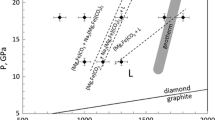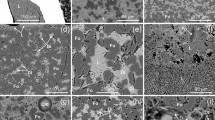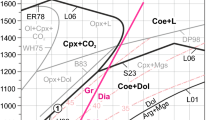Abstract
We performed an experimental study, designed to reproduce the formation of an unusual merwinite + olivine-bearing mantle assemblage recently described as a part of a Ca-rich suite of inclusions in sublithospheric diamonds, through the interaction of peridotite with an alkali-rich Ca-carbonatite melt, derived from deeply subducted oceanic crust. In the first set of experiments, we studied the reaction between powdered Mg-silicates, olivine and orthopyroxene, and a model Ca-carbonate melt (molar Na:K:Ca = 1:1:2), in a homogeneous mixture, at 3.1 and 6.5 GPa. In these equilibration experiments, we observed the formation of a merwinite + olivine-bearing assemblage at 3.1 GPa and 1200 °C and at 6.5 GPa and 1300–1400 °C. The melts coexisting with this assemblage have a low Si and high Ca content (Ca# = molar 100 × Ca/(Ca + Mg) > 0.57). In the second set of experiments, we investigated reaction rims produced by interaction of the same Ca-carbonate melt (molar Na:K:Ca = 1:1:2) with Mg-silicate, olivine and orthopyroxene, single crystals at 3.1 GPa and 1300 °C and at 6.5 GPa and 1400 °C. The interaction of the Ca-carbonate melt with olivine leads to merwinite formation through the expected reaction: 2Mg2SiO4 (olivine) + 6CaCO3 (liquid) = Ca3MgSi2O8 (merwinite) + 3CaMg(CO3)2 (liquid). Thus, our experiments confirm the idea that merwinite in the upper mantle may originate via interaction of peridotite with Ca-rich carbonatite melt, and that diamonds hosting merwinite may have a metasomatic origin. It is remarkable that the interaction of the Ca-carbonate melt with orthopyroxene crystals does not produce merwinite both at 3.1 and 6.5 GPa. This indicates that olivine grain boundaries are preferable for merwinite formation in the upper mantle.









Similar content being viewed by others
References
Asimow PD, Stolper E (1999) Steady-state mantle–melt interactions in one dimension: I. Equilibrium transport and melt focusing. J Petrol 40(3):475–494. https://doi.org/10.1093/petroj/40.3.475
Bindi L, Safonov OG, Zedgenizov DA (2015) Merwinite-structured phases as a potential host of alkalis in the upper mantle. Contrib Mineral Petrol 170(2):14. https://doi.org/10.1007/s00410-015-1173-0
Brenker FE, Vincze L, Vekemans B, Nasdala L, Stachel T, Vollmer C, Kersten M, Somogyi A, Adams F, Joswig W (2005) Detection of a Ca-rich lithology in the Earth’s deep (> 300 km) convecting mantle. Earth Planet Sci Lett 236(3–4):579–587. https://doi.org/10.1016/j.epsl.2005.05.021
Brenker FE, Vollmer C, Vincze L, Vekemans B, Szymanski A, Janssens K, Szaloki I, Nasdala L, Joswig W, Kaminsky F (2007) Carbonates from the lower part of transition zone or even the lower mantle. Earth Planet Sci Lett 260(1–2):1–9. https://doi.org/10.1016/j.epsl.2007.02.038
Brey GP, Bulatov VK, Girnis AV, Lahaye Y (2008) Experimental melting of carbonated peridotite at 6–10 GPa. J Petrol 49(4):797–821. https://doi.org/10.1093/petrology/egn002
Bulanova GP (1995) The formation of diamonds. J Geochem Explor 53(1–3):1–23. https://doi.org/10.1016/0375-6742(94)00016-5
Bulanova GP, Walter MJ, Smith CB, Kohn SC, Armstrong LS, Blundy J, Gobbo L (2010) Mineral inclusions in sublithospheric diamonds from Collier 4 kimberlite pipe, Juina, Brazil: subducted protoliths, carbonated melts and primary kimberlite magmatism. Contrib Mineral Petrol 160(4):489–510. https://doi.org/10.1007/s00410-010-0490-6
Bulatov V, Brey G, Girnis A, Gerdes A, Höfer H (2014) Carbonated sediment–peridotite interaction and melting at 7.5–12 GPa. Lithos 200–201:368–385. https://doi.org/10.1016/j.lithos.2014.05.010
Burnham AD, Bulanova GP, Smith CB, Whitehead SC, Kohn SC, Gobbo L, Walter MJ (2016) Diamonds from the Machado River alluvial deposit, Rondônia, Brazil, derived from both lithospheric and sublithospheric mantle. Lithos 265:199–213. https://doi.org/10.1016/j.lithos.2016.05.022
Bussweiler Y, Stone RS, Pearson DG, Luth RW, Stachel T, Kjarsgaard BA, Menzies A (2016) The evolution of calcite-bearing kimberlites by melt-rock reaction: evidence from polymineralic inclusions within clinopyroxene and garnet megacrysts from Lac de Gras kimberlites, Canada. Contrib Mineral Petrol 171(7):65. https://doi.org/10.1007/s00410-016-1275-3
Daines MJ, Kohlstedt DL (1994) The transition from porous to channelized flow due to melt/rock reaction during melt migration. Geophys Res Lett 21(2):145–148. https://doi.org/10.1029/93GL03052
Dasgupta R, Hirschmann MM (2010) The deep carbon cycle and melting in Earth’s interior. Earth Planet Sci Lett 298(1–2):1–13. https://doi.org/10.1016/j.epsl.2010.06.039
Dasgupta R, Hirschmann MM, Withers AC (2004) Deep global cycling of carbon constrained by the solidus of anhydrous, carbonated eclogite under upper mantle conditions. Earth Planet Sci Lett 227(1–2):73–85. https://doi.org/10.1016/j.epsl.2004.08.004
Frost DJ, McCammon CA (2008) The redox state of Earth’s mantle. Annu Rev Earth Planet Sci 36:389–420. https://doi.org/10.1146/annurev.earth.36.031207.124322
Ghosh S, Litasov K, Ohtani E (2014) Phase relations and melting of carbonated peridotite between 10 and 20 GPa: a proxy for alkali- and CO2-rich silicate melts in the deep mantle. Contrib Mineral Petrol 167(2):964. https://doi.org/10.1007/s00410-014-0964-z
Giuliani A, Kamenetsky VS, Phillips D, Kendrick MA, Wyatt BA, Goemann K (2012) Nature of alkali-carbonate fluids in the sub-continental lithospheric mantle. Geology 40(11):967–970. https://doi.org/10.1130/g33221.1
Golovin AV, Sharygin IS, Korsakov AV (2017) Origin of alkaline carbonates in kimberlites of the Siberian craton: evidence from melt inclusions in mantle olivine of the Udachnaya-East pipe. Chem Geol 455:357–375. https://doi.org/10.1016/j.chemgeo.2016.10.036
Grassi D, Schmidt MW (2011) The melting of carbonated pelites from 70 to 700 km depth. J Petrol 52(4):765–778. https://doi.org/10.1093/petrology/egr002
Hammouda T (2003) High-pressure melting of carbonated eclogite and experimental constraints on carbon recycling and storage in the mantle. Earth Planet Sci Lett 214(1–2):357–368. https://doi.org/10.1016/s0012-821x(03)00361-3
Hammouda T, Laporte D (2000) Ultrafast mantle impregnation by carbonatite melts. Geology 28(3):283–285. https://doi.org/10.1130/0091-7613(2000)28<283:umibcm>2.0.co;2
Harte B, Richardson S (2012) Mineral inclusions in diamonds track the evolution of a Mesozoic subducted slab beneath West Gondwanaland. Gondwana Res 21(1):236–245. https://doi.org/10.1016/j.gr.2011.07.001
Honnorez J, Kirst P (1975) Petrology of rodingites from the equatorial Mid-Atlantic fracture zones and their geotectonic significance. Contrib Mineral Petrol 49(3):233–257. https://doi.org/10.1007/BF00376590
Jones AP, Genge M, Carmody L (2013) Carbonate melts and carbonatites. Rev Mineral Geochem 75:289–322. https://doi.org/10.2138/rmg.2013.75.12
Kaminsky F, Wirth R, Matsyuk S, Schreiber A, Thomas R (2009) Nyerereite and nahcolite inclusions in diamond: evidence for lower-mantle carbonatitic magmas. Mineral Mag 73(5):797–816. https://doi.org/10.1180/minmag.2009.073.5.797
Kaminsky FV, Wirth R, Schreiber A (2013) Carbonatitic inclusions in deep mantle diamond from Juina, Brazil: new minerals in the carbonate-halide association. Can Mineral 51(5):669–688. https://doi.org/10.3749/canmin.51.5.669
Kaminsky FV, Ryabchikov ID, Wirth R (2016) A primary natrocarbonatitic association in the Deep Earth. Mineral Petrol 110(2–3):387–398. https://doi.org/10.1007/s00710-015-0368-4
Kelemen PB, Whitehead JA, Aharonov E, Jordahl KA (1995) Experiments on flow focusing in soluble porous media, with applications to melt extraction from the mantle. J Geophys Res Solid Earth 100(B1):475–496. https://doi.org/10.1029/94jb02544
Keller T, Katz RF (2016) The role of volatiles in reactive melt transport in the asthenosphere. J Petrol 57(6):1073–1108. https://doi.org/10.1093/petrology/egw030
Keshav S, Gudfinnsson GH (2010) Experimentally dictated stability of carbonated oceanic crust to moderately great depths in the Earth: results from the solidus determination in the system CaO–MgO–Al2O3–SiO2–CO2. J Geophys Res Solid Earth 115:B05205. https://doi.org/10.1029/2009JB006457
Kiseeva ES, Litasov KD, Yaxley GM, Ohtani E, Kamenetsky VS (2013a) Melting and phase relations of carbonated eclogite at 9–21 GPa and the petrogenesis of alkali-rich melts in the deep mantle. J Petrol 54(8):1555–1583. https://doi.org/10.1093/petrology/egt023
Kiseeva ES, Yaxley GM, Stepanov AS, Tkalčić H, Litasov KD, Kamenetsky VS (2013b) Metapyroxenite in the mantle transition zone revealed from majorite inclusions in diamonds. Geology 41(8):883–886. https://doi.org/10.1130/G34311.1
Kiseeva ES, Wood BJ, Ghosh S, Stachel T (2016) The pyroxenite-diamond connection. Geochem Perspect Lett 2:1–9. https://doi.org/10.7185/geochemlet.1601
Klein-BenDavid O, Logvinova AM, Schrauder M, Spetius ZV, Weiss Y, Hauri EH, Kaminsky FV, Sobolev NV, Navon O (2009) High-Mg carbonatitic microinclusions in some Yakutian diamonds—a new type of diamond-forming fluid. Lithos 112:648–659. https://doi.org/10.1016/j.lithos.2009.03.015
Kohlstedt DL, Holtzman BK (2009) Shearing melt out of the Earth: an experimentalist’s perspective on the influence of deformation on melt extraction. Annu Rev Earth Planet Sci 37:561–593. https://doi.org/10.1146/annurev.earth.031208.100104
Lambart S, Laporte D, Schiano P (2009) An experimental study of focused magma transport and basalt–peridotite interactions beneath mid-ocean ridges: implications for the generation of primitive MORB compositions. Contrib Mineral Petrol 157(4):429–451. https://doi.org/10.1007/s00410-008-0344-7
Lavrent’ev YG, Karmanov NS, Usova LV (2015) Electron probe microanalysis of minerals: microanalyzer or scanning electron microscope? Russ Geol Geophys 56(8):1154–1161. https://doi.org/10.1016/j.rgg.2015.07.006
Litasov KD (2011) Physicochemical conditions for melting in the Earth’s mantle containing a C–O–H fluid (from experimental data). Russ Geol Geophys 52(5):475–492. https://doi.org/10.1016/j.rgg.2011.04.001
Litasov KD, Ohtani E (2009) Solidus and phase relations of carbonated peridotite in the system CaO–Al2O3–MgO–SiO2–Na2O–CO2 to the lower mantle depths. Phys Earth Planet Inter 177(1–2):46–58. https://doi.org/10.1016/j.pepi.2009.07.008
Litasov K, Ohtani E (2010) The solidus of carbonated eclogite in the system CaO–Al2O3–MgO–SiO2–Na2O–CO2 to 32 GPa and carbonatite liquid in the deep mantle. Earth Planet Sci Lett 295(1–2):115–126. https://doi.org/10.1016/j.epsl.2010.03.030
Litasov KD, Shatskiy A, Ohtani E (2013a) Earth’s mantle melting in the presence of C–O–H-bearing fluid. In: Karato S (ed) Physics and chemistry of the deep Earth. Wiley, New York, pp 38–65
Litasov KD, Shatskiy A, Ohtani E, Yaxley GM (2013b) Solidus of alkaline carbonatite in the deep mantle. Geology 41(1):79–82. https://doi.org/10.1130/G33488.1
Logvinova AM, Wirth R, Fedorova EN, Sobolev NV (2008) Nanometre-sized mineral and fluid inclusions in cloudy Siberian diamonds: new insights on diamond formation. Eur J Mineral 20(3):317–331. https://doi.org/10.1127/0935-1221/2008/0020-1815
Malkovets VG, Rezvukhin DI, Belousova EA, Griffin WL, Sharygin IS, Tretiakova IG, Gibsher AA, O’Reilly SY, Kuzmin DV, Litasov KD, Loginova AM, Pokhilenko NP, Sobolev NV (2016) Cr-rich rutile: a powerful tool for diamond exploration. Lithos 265:304–311. https://doi.org/10.1016/j.lithos.2016.08.017
Maruyama S, Santosh M, Zhao D (2007) Superplume, supercontinent, and post-perovskite: mantle dynamics and anti-plate tectonics on the Core–Mantle Boundary. Gondwana Res 11(1–2):7–37. https://doi.org/10.1016/j.gr.2006.06.003
Meyer HOA, Boyd FR (1972) Composition and origin of crystalline inclusions in natural diamonds. Geochim Cosmochim Acta 36(11):1255–1273. https://doi.org/10.1016/0016-7037(72)90048-8
Moriyama J, Kawabe I, Fujino K, Ohtani E (1992) Experimental study of element partitioning between majorite, olivine, merwinite, diopside and silicate melts at 16 GPa and 2000 °C. Geochem J 26(6):357–382. https://doi.org/10.2343/geochemj.26.357
Palyanov YN, Bataleva YV, Sokol AG, Borzdov YM, Kupriyanov IN, Reutsky VN, Sobolev NV (2013) Mantle–slab interaction and redox mechanism of diamond formation. Proc Natl Acad Sci USA 110(51):20408–20413. https://doi.org/10.1073/pnas.1313340110
Pearson DG, Shirey SB, Canil D (2003) Mantle samples included in volcanic rocks: xenoliths and diamonds. In: Carlson RW, Holland HD, Turekian KK (eds) Treatise on geochemistry, vol 2: geochemistry of the Mantle and Core. Elsevier, Amsterdam, pp 171–275
Pearson DG, Brenker FE, Nestola F, McNeill J, Nasdala L, Hutchison MT, Matveev S, Mather K, Silversmit G, Schmitz S, Vekemans B, Vincze L (2014) Hydrous mantle transition zone indicated by ringwoodite included within diamond. Nature 507(7491):221–224. https://doi.org/10.1038/nature13080
Plank T, Langmuir CH (1998) The chemical composition of subducting sediment and its consequences for the crust and mantle. Chem Geol 145(3–4):325–394. https://doi.org/10.1016/S0009-2541(97)00150-2
Reiners PW (1998) Reactive melt transport in the mantle and geochemical signatures of mantle-derived magmas. J Petrol 39(5):1039–1061. https://doi.org/10.1093/petroj/39.5.1039
Ringwood AE (1991) Phase transformations and their bearing on the constitution and dynamics of the mantle. Geochim Cosmochim Acta 55(8):2083–2110. https://doi.org/10.1016/0016-7037(91)90090-R
Rohrbach A, Schmidt MW (2011) Redox freezing and melting in the Earth’s deep mantle resulting from carbon–iron redox coupling. Nature 472:209–212. https://doi.org/10.1038/nature09899
Safonov OG (2011) Kamafugite melts as products of interaction between peridotite and chloride-carbonate liquids at pressures 1–7 GPa. Dokl Earth Sci 440(1):1276–1281. https://doi.org/10.1134/S1028334X11090091
Safonov OG, Perchuk LL, Litvin YA (2007) Melting relations in the chloride-carbonate-silicate systems at high-pressure and the model for formation of alkalic diamond-forming liquids in the upper mantle. Earth Planet Sci Lett 253(1–2):112–128. https://doi.org/10.1016/j.epsl.2006.10.020
Safonov OG, Chertkova NV, Perchuk LL, Litvin YA (2009) Experimental model for alkalic chloride-rich liquids in the upper mantle. Lithos 112:260–273. https://doi.org/10.1016/j.lithos.2009.03.021
Sharygin IS, Golovin AV, Korsakov AV, Pokhilenko NP (2013) Eitelite in sheared peridotite xenoliths from Udachnaya-East kimberlite pipe (Russia)—a new locality and host rock type. Eur J Mineral 25(5):825–834. https://doi.org/10.1127/0935-1221/2013/0025-2315
Sharygin IS, Litasov KD, Shatskiy A, Golovin AV, Ohtani E, Pokhilenko NP (2015) Melting phase relations of the Udachnaya-East Group-I kimberlite at 3.0–6.5 GPa: experimental evidence for alkali-carbonatite composition of primary kimberlite melts and implications for mantle plumes. Gondwana Res 28(4):1391–1414. https://doi.org/10.1016/j.gr.2014.10.005
Sharygin IS, Golovin AV, Korsakov AV, Pokhilenko NP (2016) Tychite in mantle xenoliths from kimberlites: the first find and a new genetic type. Dokl Earth Sci 467(1):270–274. https://doi.org/10.1134/S1028334X16030065
Shatskiy A, Litasov KD, Borzdov YM, Katsura T, Yamazaki D, Ohtani E (2013a) Silicate diffusion in alkali-carbonatite and hydrous melts at 16.5 and 24 GPa: implication for the melt transport by dissolution-precipitation in the transition zone and uppermost lower mantle. Phys Earth Planet Inter 225:1–11. https://doi.org/10.1016/j.pepi.2013.09.004
Shatskiy A, Sharygin IS, Gavryushkin PN, Litasov KD, Borzdov YM, Shcherbakova AV, Higo Y, Funakoshi K, Palyanov YN, Ohtani E (2013b) The system K2CO3–MgCO3 at 6 GPa and 900–1450 °C. Am Mineral 98(8–9):1593–1603. https://doi.org/10.2138/am.2013.4407
Shatskiy AF, Litasov KD, Palyanov YN (2015) Phase relations in carbonate systems at pressures and temperatures of lithospheric mantle: review of experimental data. Russ Geol Geophys 56(1–2):113–142. https://doi.org/10.1016/j.rgg.2015.01.007
Shatskiy A, Litasov KD, Sharygin IS, Egonin IA, Mironov AM, Palyanov YN, Ohtani E (2016a) The system Na2CO3–CaCO3–MgCO3 at 6 GPa and 900–1250 °C and its relation to the partial melting of carbonated mantle. High Press Res 36(1):23–41. https://doi.org/10.1080/08957959.2015.1135916
Shatskiy A, Litasov KD, Palyanov YN, Ohtani E (2016b) Phase relations on the K2CO3–CaCO3–MgCO3 join at 6 GPa and 900–1400 °C: implications for incipient melting in carbonated mantle domains. Am Mineral 101(2):437–447. https://doi.org/10.2138/am-2016-5332
Shatskiy A, Litasov KD, Sharygin IS, Ohtani E (2017) Composition of primary kimberlite melt in a garnet lherzolite mantle source: constraints from melting phase relations in anhydrous Udachnaya-East kimberlite with variable CO2 content at 6.5 GPa. Gondwana Res 45:208–227. https://doi.org/10.1016/j.gr.2017.02.009
Shaw CSJ (1999) Dissolution of orthopyroxene in basanitic magma between 0.4 and 2 GPa: further implications for the origin of Si-rich alkaline glass inclusions in mantle xenoliths. Contrib Mineral Petrol 135(2–3):114–132. https://doi.org/10.1007/s004100050501
Shirey SB, Cartigny P, Frost DJ, Keshav S, Nestola F, Nimis P, Pearson DG, Sobolev NV, Walter MJ (2013) Diamonds and the geology of mantle carbon. Rev Mineral Geochem 75:355–421. https://doi.org/10.2138/rmg.2013.75.12
Sobolev NV, Bartoshinsky ZV, Yefimova ES, Lavrent’yev YG, Pospelova LN (1970) Association of olivine, garnet and chrome-diopside from Yakutian diamonds. Dokl Acad Nauk SSSR 192(6):1349–1353
Sokol AG, Kruk AN, Chebotarev DA, Palyanov YN (2016) Carbonatite melt–peridotite interaction at 5.5–7.0 GPa: implications for metasomatism in lithospheric mantle. Lithos 248–261:66–79. https://doi.org/10.1016/j.lithos.2016.01.013
Soltys A, Giuliani A, Phillips D, Kamenetsky VS, Maas R, Woodhead J, Rodemann T (2016) In-situ assimilation of mantle minerals by kimberlitic magmas—Direct evidence from a garnet wehrlite xenolith entrained in the Bultfontein kimberlite (Kimberley, South Africa). Lithos 256–257:182–196. https://doi.org/10.1016/j.lithos.2016.04.011
Stachel T, Brey GP, Harris JW (2005) Inclusions in sublithospheric diamonds: glimpses of deep Earth. Elements 1(2):73–78. https://doi.org/10.2113/gselements.1.2.73
Stagno V, Frost DJ (2010) Carbon speciation in the asthenosphere: experimental measurements of the redox conditions at which carbonate-bearing melts coexist with graphite or diamond in peridotite assemblages. Earth Planet Sci Lett 300(1–2):72–84. https://doi.org/10.1016/j.epsl.2010.09.038
Stagno V, Ojwang DO, McCammon CA, Frost DJ (2013) The oxidation state of the mantle and the extraction of carbon from Earth’s interior. Nature 493:84–88. https://doi.org/10.1038/nature11679
Thibault Y, Edgar AD, Lloyd FE (1992) Experimental investigation of melts from a carbonated phlogopite lherzolite: Implications for metasomatism in the continental lithospheric mantle. Am Mineral 77(7–8):784–794
Thomson AR, Walter MJ, Kohn SC, Brooker RA (2016) Slab melting as a barrier to deep carbon subduction. Nature 529(7584):76–79. https://doi.org/10.1038/nature16174 doi
Torsvik TH, Burke K, Steinberger B, Webb SJ, Ashwal LD (2010) Diamonds sampled by plumes from the core–mantle boundary. Nature 466(7304):352–355. https://doi.org/10.1038/nature09216
van Achterbergh E, Griffin WL, Ryan CG, O’Reilly SY, Pearson NJ, Kivi K, Doyle BJ (2002) Subduction signature for quenched carbonatites from the deep lithosphere. Geology 30(8):743–746. https://doi.org/10.1130/0091-7613(2002)030<0743:ssfqcf>2.0.co;2
Zedgenizov DA, Rege S, Griffin WL, Kagi H, Shatsky VS (2007) Composition of trapped fluids in cuboid fibrous diamonds from the Udachnaya kimberlite: LAM-ICPMS analysis. Chem Geol 240(1–2):151–162. https://doi.org/10.1016/j.chemgeo.2007.02.003
Zedgenizov DA, Shatskiy A, Ragozin AL, Kagi H, Shatsky VS (2014) Merwinite in diamond from São Luiz, Brazil: a new mineral of the Ca-rich mantle environment. Am Mineral 99(2–3):547–550. https://doi.org/10.2138/am.2014.4767
Zedgenizov DA, Ragozin AL, Kalinina VV, Kagi H (2016) The mineralogy of Ca-rich inclusions in sublithospheric diamonds. Geochem Int 54(10):890–900. https://doi.org/10.1134/S0016702916100116
Acknowledgements
We thank two anonymous reviewers for their constructive and thoughtful comments. This work was supported by the Russian Science Foundation (Grant no. 14-17-00609) and was performed under a program of the Ministry of Education and Science of the Russian Federation (Project no. 14.B25.31.0032).
Author information
Authors and Affiliations
Corresponding author
Additional information
Communicated by Hans Keppler.
Electronic supplementary material
Below is the link to the electronic supplementary material.
Rights and permissions
About this article
Cite this article
Sharygin, I.S., Shatskiy, A., Litasov, K.D. et al. Interaction of peridotite with Ca-rich carbonatite melt at 3.1 and 6.5 GPa: Implication for merwinite formation in upper mantle, and for the metasomatic origin of sublithospheric diamonds with Ca-rich suite of inclusions. Contrib Mineral Petrol 173, 22 (2018). https://doi.org/10.1007/s00410-017-1432-3
Received:
Accepted:
Published:
DOI: https://doi.org/10.1007/s00410-017-1432-3




